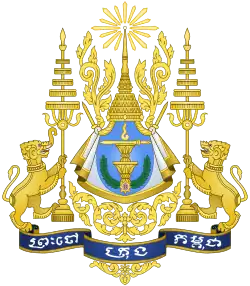Crime in Cambodia
Crime in Cambodia is present in various forms.

Crime by type
Corruption
The rate of corruption in Cambodia is high; one source goes on to describe the situation as "nothing less than obscene". Corruption is considered a large expense to the Cambodian government.[1] The Cambodian police force is known to inappropriately use violence in certain cases.[2] The misuse of ferocity has raised concerns from the Human Rights Watch.[3]Petty crime is common, with tourist areas often targeted. This includes snatch theft and pick-pocketing. Perpetrators are usually stricken with poverty, and as a result are driven to steal from foreigners with the knowledge that they bring about a significant amount of money and other valuable items. Owing to the easy accessibility of arms, armed robbery also occurs.
Fraud
Tens of thousands of Asians from different countries have been lured to casinos and resorts in Cambodia (but also Laos and Myanmar). These victimes would then be forced to work in illegal online-gambling or scamming outfits. These illegal operations are organised by ethnic-Chinese gangs that sometimes collaborate with local counterparts.[4]
Illegal logging
Murder
In 2017, Cambodia had a homicide rate of 2.4 per 100,000 population.[7]
Prostitution
Prostitution is against the law in Cambodia, but still present and only growing. Le Thi Quy, a professor from the Women's Research Center, interviewed a handful of females in 1993 about prostitution; three quarters of the interviewees found being a prostitute to be a norm and a profession they felt was not shameful having.[8] That same year, the professor estimated that there were some one hundred thousand sex workers in the country.[8]
Robbery
Petty crime is common, with tourist areas often targeted. This includes snatch theft and pick-pocketing. Perpetrators are usually stricken with poverty, and as a result are driven to steal from foreigners with the knowledge that they bring about a significant amount of money and other valuable items. Owing to the easy accessibility of arms, armed robbery also occurs.[9]
Sex trafficking
Cambodian citizens, primarily women and girls, have been sex trafficked within the country and throughout the world.[10] They are threatened and forced into prostitution, marriages, and or pregnancies.[11]
Violence against women
In 2008, the national survey showed that over one quarter of women in Cambodia suffered from domestic violence.[12] A 2013 UN report showed that 1 in 5 men in Cambodia between the ages of 18 and 49 had admitted that they had raped a woman.[13] 15.8% of those who admitted to having committed a rape had done so when they were younger than 15 years old.[13] “Bauk” is the term used in Cambodia for gang rape.[13] More than double the men in Cambodia admitted to gang rape in comparison to India.[14]
See also
References
- Curtis, Grant (1998). Cambodia Reborn?: The Transition to Democracy and Development. Brookings Institution Press. pp. 147–. ISBN 9780815791379.
- "Protest Claims Police Brutality in Cambodian Home". 95.5 WBRU. January 14, 2013. Archived from the original on December 12, 2013.
- "Cambodia: Escalating Violence, Misuse of Courts". Human Rights Watch. February 1, 2013.
- "The gangs that kidnap Asians and force them to commit cyberfraud". The Economist. ISSN 0013-0613. Retrieved 2022-10-07.
- Ikunaga, Meguri. The Forest Issue in Cambodia : Current Situation and Problems : An Analysis Based on Field Research. Occasional Paper. Tokyo: Foundation for Advanced Studies on International Development, International Development Research Institute, 1999. Print.
- Hansen, Kasper K., and Neth Top. Natural Forest Benefits and Economic Analysis of Natural Forest Conversion in Cambodia. Working paper no. 33. Phnom Penh: Cambodia Development Resource Institute, 2006. Print.
- Global Study on Homicide. United Nations Office on Drugs and Crime, 2013.
- Barry, Kathleen (1996). The Prostitution of Sexuality. NYU Press. pp. 137–. ISBN 9780814712771.
- "Cambodia". travel.state.gov. Archived from the original on June 20, 2013. Retrieved June 13, 2013.
- "Cambodia UN ACT". UN ACT.
- "Inside the world of Cambodia's child sex trade, as told through the eyes of a survivor". ABC News. March 8, 2017.
- UNIFEM; World Bank; ADB; UNDP; DFID (2004). A Fair Share for Women: Cambodia Gender Assessment (PDF). ISBN 1-932827-00-5.
- Henderson, Simon (11 September 2013). "UN Report Says 1 in 5 Cambodian Men have Raped". The Cambodia Daily.
- Callan, Aela (8 March 2013). "It's a Man's World". Al Jazeera.
